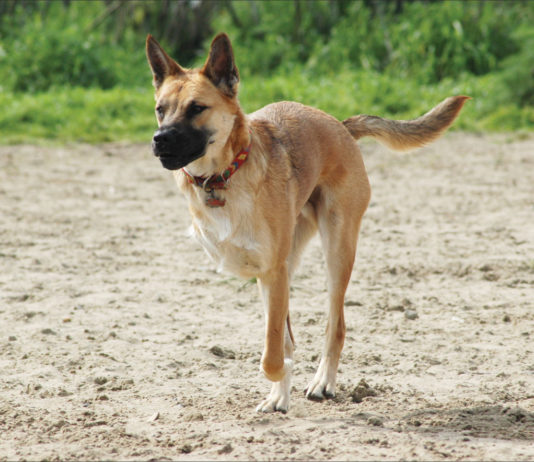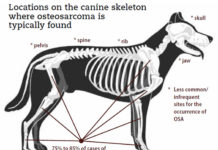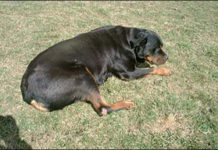A New Bone Cancer Vaccine for Dogs
Osteosarcoma is the most common type of bone tumor diagnosed in dogs, affecting an estimated 10,000 dogs each year in the U.S. alone. Too many owners are aware that this disease can be extremely aggressive with a poor prognosis.
What Are the Treatment Options For Dogs With Mast Cell Tumors?
Mast cell tumors (MCTs) are the most common form of malignant skin cancer in dogs, accounting for approximately 7% to 21% of all skin...
Studies Have Linked Lawn Pesticides with Canine Malignant Lymphoma
It's a ton of fun to see an athletic, healthy dog sprinting across a sprawling lawn of thick green grass but could this practice be dangerous to the dog's health? A study presented in the January 2012 issue of the journal Environmental Research concluded that exposure to professionally applied lawn pesticides was associated with a significantly (70 percent) higher risk of canine malignant lymphoma (CML). It's a broad conclusion and light on specifics. The case-control study, conducted between January 2000 and December 2006 at the Foster Hospital for Small Animals at Tufts University's Cummings School of Veterinary Medicine, was structured around a 10-page questionnaire that was mailed to dog owners who were having their pets treated at the Foster Hospital; the resulting data came from the owners of 266 dogs with confirmed cases of CML and 478 dogs in two control groups (non-CML cases).
Do Your Homework
His research and willingness to innovate pays off, as this dedicated owner helps his dog outlive her diagnosis.
Neutering Saves Lives by Reducing Cancer Risks
Most people respond with a warm fuzzy Awwww" reaction when they see a litter of puppies. After all
Osteosarcoma: Causes, Diagnosis, and Treatment
Osteosarcoma (OSA) has been found in every vertebrate class and has even been identified in dinosaur fossils, but it appears to be more prevalent...
Special Diets for Dogs With Cancer
In the relationship between cancer and nutrition, there are few conclusive answers. The modalities of both are complex, and neither is completely understood. However, enhanced nutrition is of unquestionable benefit to any dog with cancer, and to any dog with an increased risk of developing cancer. And of the many known factors leading to canine cancer, proper nutrition is the one which dog owners can best control, enhancing a dog's overall health, and improving the body's natural defense against cancer. Those positive words must be followed with some cautions. Cancer diets often emphasize or restrict certain nutrients, in order to promote certain biochemical actions or to thwart others.
Chemotherapy for Dogs: What to Expect
Cancer. My heart dropped to my stomach. In February 2010 my Border Collie Daisy became one of an estimated six million dogs diagnosed with cancer each year. Chemotherapy. My stomach tumbled to my feet. The diagnosis was scary enough; how could I possibly consider chemotherapy? I had visions of a treatment worse than the disease itself. As it turns out, my preconceptions of chemotherapy were far worse than its reality. Chemo hasn't cured my dog more on that later but it's given us more than 18 months (and counting) of joyful, quality time together.
Finding Dog Lymph Node Locations
There are over 400 lymph nodes in your dog but only a few are close enough to the skin’s surface to be observed. Though few, these key nodes are important indicators of illness.
What Are the Alternatives for Treating Cancer in Dogs?
The high-tech world of modern medicine has so many weapons that its “war on cancer” arsenal promises something for everyone. But all along, there have been patients, physicians, veterinarians, and animal caregivers who refuse chemotherapy, radiation treatments, surgery, prescription drugs, and other oncology protocols.
Canine Cancer Therapy Update
Despite everything modern medicine has to offer, cancer in dogs remains among the most feared of canine diseases. Just over a year ago, Whole Dog Journal reviewed conventional, complementary, and alternative cancer therapies in a series of articles. Since then, a cancer vaccine has been approved for veterinary use and a new version of an old herbal salve has become a “first choice” for many holistic veterinarians.
Canine Lipomas
Lumps, bumps, fatty tumors – call them what you will, but nobody likes to see her dog develop lipomas, those persistent little foothills that can sprout up on older dogs – and sometimes, not so-old ones. Often soft and squishy to the touch, benign fatty tumors are not a threat to your dog’s health. (The exception is infiltrative lipomas, which can invade muscle tissue, but these are relatively rare.) While lipomas can be unsightly, many vets opt not to remove them unless they are in a location where their growth impedes a dog’s mobility. But many holistic veterinarians see lipomas as far from innocuous. Instead, they stress, lipomas are symptoms of a bigger problem.


















